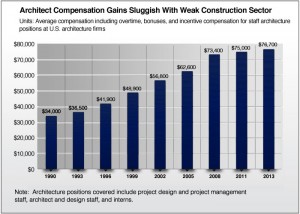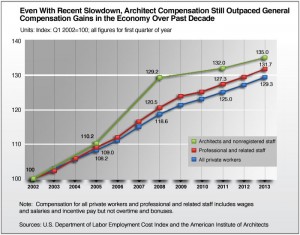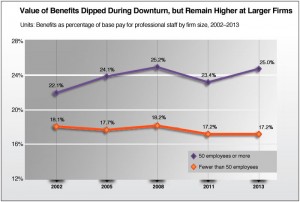Lingering impact from the Great Recession slows gains in salaries
Over the last several years, most architecture firms have benefited from a general improvement in the economy as well as in the construction sector. Revenue at architecture firms increased almost 11 percent in 2012 from 2011 levels, according to U.S. Census Bureau figures, and firm payrolls have followed suit. But this modest improvement in business conditions has done little to lift compensation levels at firms. Between 2011 and 2013, average total compensation for architecture positions—including base salary, overtime, bonuses, and incentive compensation—increased only slightly over 1 percent per year, barely more than the average increase in compensation between 2008 and 2011, when the construction sector was still in steep decline.
Even this modest 1 percent increase in average architect compensation may overstate the experience of the typical architect during this period. Average compensation depends on the mix, by experience levels, of positions reporting. Since many less experienced architecture positions were eliminated during the downturn, current average compensation may reflect a higher share of more experienced (and more highly compensated) positions. Regardless, while average compensation for architecture positions increased a mere 0.7 percent per year compounded between 2008 and 2011, growth increased to only 1.1 percent per year between 2011 and 2013 (Exhibit 1.1).
Architecture staff compensation tends to be more volatile over the business cycle than compensation for most other occupations. Over the past decade, compensation gains for architecture positions have more than kept pace with compensation across the entire economy. Architecture compensation increased 35 percent between early 2002 and early 2013, compared to just under 32 percent for all professional and related staff (typically defined as white-collar workers such as lawyers, accountants, etc.), and just over 29 percent for all private-sector workers (Exhibit 1.2).
Compensation levels vary by firm size
Historically, large architecture firms have offered higher levels of compensation. These comparisons are more difficult for more senior positions because job responsibilities are difficult to compare across firms of different sizes. However, this disparity exists even for positions with relatively standard job descriptions such as Intern 1 or Architect 1.
At firms with fewer than 10 employees, Intern 1 compensation averaged 10 to 15 percent below national averages. At firms with more than 250 employees, Intern 1 compensation averaged more than 10 percent above the national average. A similar pattern held for Architect 1 positions: about 10 percent below the national average at firms with fewer than 10 employees, and almost 10 percent above the national average at firms with 250 or more employees.
Staff turnover and fringe benefits reflect improvement
Another sign that business conditions have stabilized across the profession is that benefits offered to employees have begun to modestly improve at many firms. While declining between 2008 and 2011 as firm revenues eroded, they rebounded modestly by 2013, with benefits packages averaging 18 percent of base salaries for professional staff. Benefits have bounced back faster at larger firms and remain significantly higher than those offered by smaller firms (Exhibit 1.3).
Recent Related:
AIA Compensation Survey: Architect Compensation Stagnant
Reference:
Purchase the 2013 AIA Compensation Report
New for 2013: Architect Compensation by Metro Area












No comments so far!